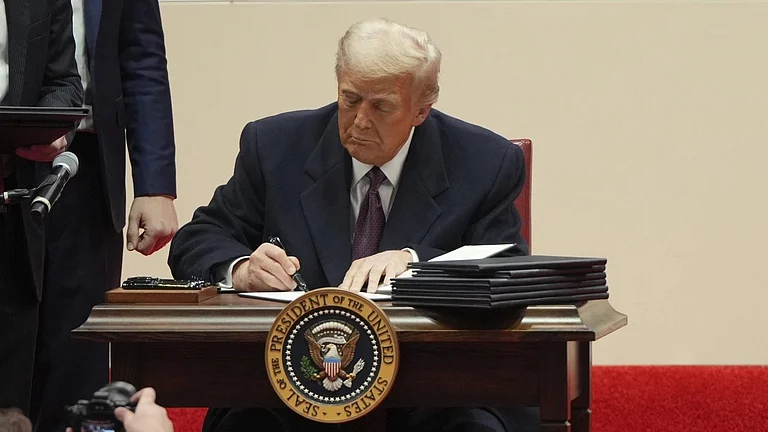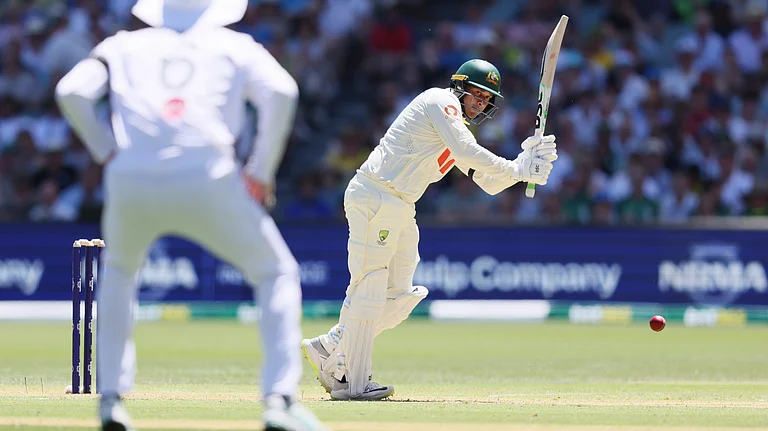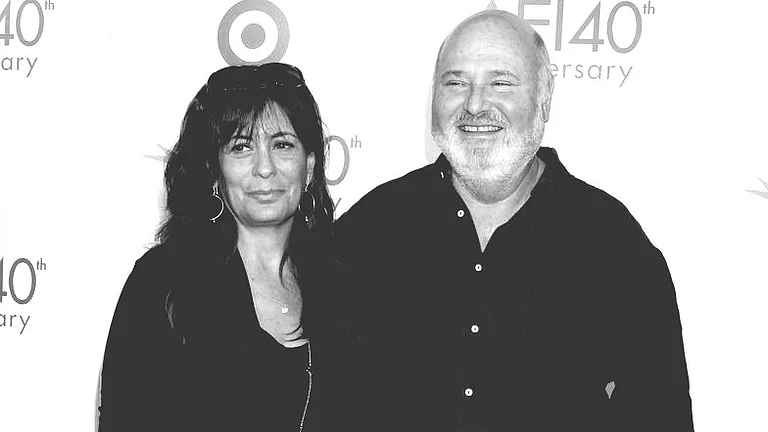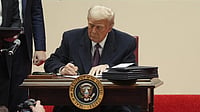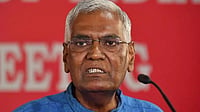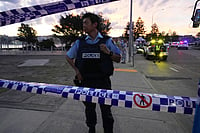The Sun had risen fairly high when we reached Amritsar... Every time I visited Amritsar, I felt captivated. But the city this time presented the look of a cremation ghat, eerie and stink ing... The silence was so perfect that even the faint hiss of steam from the stationary engine sounded like a shriek. Only some Sikhs were hanging about, with unsheathed kirpans which they occasionally brandished... The brief stoppage seemed to have lingered into eternity till the engine whistled and gave a gentle pull... We left Chheharta and then Atari and when we entered Wagah and Harbanspura everyone in the train felt uplifted. A journey through a virtual valley of destruction ended when finally the train came toa halt at Platform No 2-Lahore, the moment was as gratifying as the consummation of a dream.
Mohammad Saeed, Lahore:
A Memoir (Lahore, 1989), p.94
PARTITION cast its shadow over many aspects ofstate and society. Yet the literature on this major event is mostly inadequate,impressionistic, and lacking in scholarly rigour. Even after 50 years ofIndependence and despite the access to wide-ranging primary source materials inlibraries and archives, there are no convincing arguments that explain why andhow the two-nation theory emerged, why and how different forms of identity andconsciousness were translated into a powerful campaign for a Muslim state, whyand when the Muslim League enlarged its constituency, and why the vivisection ofthe subcontinent created at least 10 million refugees and resulted in at leastone million deaths.
Part of the reason is the flawed frame of reference, the inclination of manywriters to draw magisterial conclusions from isolated events, their readiness toconstruct identities around religious lines, and their engagement with all-Indiaparties, like the Indian National Congress and the Muslim League, and nationalleaders like Gandhi, Jinnah and Jawaharlal Nehru. In consequence, the discussionis pitched at a general level and is essentially based on the statements ofleaders and their negotiations with British officials in Lutyen's Delhi andWhitehall.
Social scientists must intervene in the existing debates and not let thegeneralists get away with their biased views and interpretations. We need tochallenge the commonly held assumptions on Muslim politics generally, delineatethe ideological strands in the Pakistan movement, explore its unities anddiversities, and plot its growth and trajectory without preconceivedsuppositions. We need to ask, for example: Was there intrinsic merit inreligious/Islamic appeals? Does one search for clues in British policies whichwere tilted in favour of the Muslims to counter the nationalist movement?; inthe ensuing clash between Hindu and Muslim revivalist movements?; in violentcontests over religious symbols, a dispute recently played out around the BabriMasjid at Ayodhya?; in the exploitation of religious and cultural symbols andtheir manipulation by competing elites to secure a vantage-point in government,business and professions? We need to be told, furthermore, why the idea of aMuslim nation appealed to the divided and highly stratified Muslim communities,enabling Mohammed Ali Jinnah and his lieutenants to marshal resources to launchthe crusade for a separate Muslim homeland.
As a starting point, it is necessary to repudiate Jinnah's 'two-nation'theory as a plausible explanation for the birth of Pakistan. Time and time againit has been pointed out that Hindus and Muslims, having lived together forcenturies in perfect peace and amity, did not constitute separate social,economic or political entities, and that their common points of contact andassociation were based on enduring inter-social connections and shared materialinterests. Neither the followers of Islam nor of Hinduism were cohesive inthemselves. Their histories, along with social habits, cultural traits andoccupational patterns, varied from class to class, hem place to place, and fromregion to region. During his tour in 1946-47, British civil servant MalcolmDarling found, in the tract between the Beas and Sutlej rivers in Punjab, muchsimilarity between Hindus and Muslims. He asked how was Pakistan to be fittedinto these conditions? He was bothered by the same question while passingbetween the Chenab and Ravi, and commented: "What a hash politics threatensto make of this tract, where Hindu, Muslim and Sikh are as mixed up as theingredients of a well-made pilau (rice cooked with fowl or meat)...Inoted how often in a village Muslim and Sikh had a common ancestor. It is thesame here with Hindu and Muslim Rajputs.... A Hindu Rajput...tells me that wherehe lives in Karnal to the south, 50 villages had converted to Islam in the daysof Aurangzeb. They belong to the same clan as he does, and 15 years ago offeredto return to the Hindu fold, on the condition that their Hindu kinsfolk wouldgive them their daughters in marriage. The condition was refused and they arestill Muslim. In this area, even where Hindu and Muslim belong to differentclans, they still interchange civilities at marriage, inviting mullah orBrahmin, as the case may be, to share in the feasting."
If the ideological underpinnings of the two-nation theory stand refuted bythe weight of historical evidence, then the search for a political explanationof Partition must begin with the fluid political climate on the eve of andduring World War I, and with the substantive issue--one that concerned politicalparties and their constituencies--of gaining political power and leverage in theenlarged and rapidly-changing administrative and bureaucratic structures. Thisaccounts for the swiftness with which the two-nation idea succeeded in becomingactualised. In fact, the intensity of emotions involved had more to do with thepolitical and economic anxieties of various social classes than with a profoundurge to create a Muslim/Islamic state. In its conception and articulation,therefore, the vocal demand for carving out a Muslim nation summed up the fearsof the landed classes and the aspirations of the newly-emergent professionalgroups in north India and the small but influential industrial magnates ofwestern and eastern regions.
The bitter and violent contest over power-sharing culminating in Partitionreveals a great deal about the three major themes that have dominated SouthAsian historiography--colonialism, nationalism and communalism. What it does notreveal, however, is how the Partition affected millions, uprooted hem home andfield by sheer fear of death to seek safety across a line they had neither drawnnor desired. History books do not record the woes of divided families, theplight of migrants, the pain, trauma and sufferings of those who had to partfrom their kin, friends and neighbours, their deepening nostalgia for placesthey lived in for generations and forcibly abandoned, the anguish of thosedevotees who thought that destiny was taking them far away from places ofreligious worship that were part of their being, and the harrowing experiencesof countless people who bearded the train that would take them to therealisation of their dreams, but of whom not a man, woman or child survived thejourney.
Take the case of Saddan, a character in Rahi Masoom Raza's famous Hindi novelAadha Gaon (Half-a-Village), He migrated to Pakistan, but claimed to bethe same Syed Saadatul Hasnain Zaidi of village Gangauli. How could Gangauli beanother country! When in Pakistan, he would miss Shia congregations duringMuharram. "These memories were of no particular importance, they wereextremely foolish memories, but still Saddan embraced each one of them again andagain and wept. He yearned for Gangauli..."
There were many Gangaulis in India, with their Zaidis, Ghafoors and Hajis,where people did not quite understand the logic behind Muslim nationalism.Hindus and Muslims living in harmony and goodwill could not come to terms withthe ill-will and hostility conveyed through speeches and pamphlets. That is whyone can spot so many Gangaulis on India's map where the Muslim League's messagereached but failed to impress. There were, indeed, many Gangaulis where theprotagonists of Pakistan encountered bitter opposition in their bid to win overa following.
The professed ideology of nation-state itself had no great relevance orimmediacy to the millions bartered between India and Pakistan. Most Muslims werenot fascinated by Pakistan, which they neither understood nor approved of,except as a remote place where they would go, as on a pilgrimage. Some lefthoping to secure rapid promotions but not to set up permanent homes. It did notreally matter to peasants and mill-workers whether they were to be located in'India' or 'Pakistan'. Notice, for example, how Muslim employees of the EastIndia Railway in Kanpur stayed put in India after having opted for Pakistan.Consider, too, how 8,000 government servants returned to their homes in March1948, months after they had left for Pakistan.
IN other words, most people, Hindus, Muslims and Sikhs alike, were largelyunconcerned with the newly-created geographical entities. Yet they were caughtup in the cross-fire of religious hatred. Some were driven out of fear; panicand a sense of hopelessness. Most were hapless victims of a triangular gameplan,worked out by the British, the Congress and the Muslim League without care orconsideration for a vast number of people who were committed neither to a Hinduhomeland nor to an imaginary World of Islam. They had no destination toreach, no mirage to follow. They were unclear whether Lahore or Gurdaspur wouldbe in India or Pakistan. They did not know whether Delhi or Dacca would remainin Gandhi's India or Jinnah's Pakistan.
In fact, 'India' and 'Pakistan' were no more than territorial abstractions tothose who had little knowledge of how Mountbatten's Plan or the Radcliffe Awardwould change the destinies of millions and tear them apart from their familiarsocial and cultural moorings. "The English have flung away their Raj like abundle of old straw," a peasant told a British official, "and we havebeen chopped in pieces like butcher's meat". This was a telling comment bya 'subaltern' on the meaning attached to the Pakistan movement.
Saadat Hasan Manto, the famous Urdu writer, captures the mood in Toba TekSingh, one of his finest stories. "As to where Pakistan was located,the inmates knew nothing...the mad and the partially mad were unable to decidewhether they were now in India or Pakistan. If they were in India where on earthwas Pakistan?...It was also possible that the entire subcontinent of India mightbecome Pakistan. And who could say if both India and Pakistan might not entirelyvanish from the map of the world one day?"
Pakistan was won, but people on both sides of the fence were tormented bygruesome killings, by the irreparable loss of families and by the magnitude ofan epic tragedy. There were memories on both sides of living side by side withfriends, of a shared cultural and intellectual heritage, and of fightingtogether for Independence and raising the banner of revolt against colonialrule. The birth of Pakistan, a prized trophy for some, destroyed MohammadIqbal's melodious lyric of syncretic nationalism--Naya Shivala (NewTemple)--once the ideal of patriots and freedom-fighters. It severed orfragmented cultural ties, undermined a vibrant intellectual tradition andintroduced a discordant note in the civilisational rhythm of Indian society. Thebirth of freedom on that elevated day--August 14, 1947, for Pakistan andAugust 15 for India--did not bring India any ennobling benediction. On thecontrary, the country was shaken by 'a volcanic eruption'. In the words of FaizAhmad Faiz, renowned Urdu poet: This is not that long-looked-for break ofday/ Not that clear dawn in quest of which those comrades/ Set out, believingthat in heaven's wide void/Somewhere must be the star's last halt/ Somewhere theverge of night's slow-washing tide,/ Somewhere an anchorage for the ship ofheartache.
So, which country did poets like Faiz and writers like Manto belong to? Indiaor Pakistan? Manto, for one, tried in vain to separate India from Pakistan andPakistan from India. He asked himself: Will Pakistani literature bedifferent-and if so, how? To whom will now belong what had been written inundivided India? Will that be partitioned too? The uppermost question in hismind was: Were we really free? Both Hindus and Muslims were being slaughtered.Why? There were different answers: the Indian answer, the Pakistani answer, theBritish answer. Surely, "every question had an answer but when you tried tounravel the truth, you were left groping". And there was no answer.
Manto's postscript on a colossal human tragedy must not be ignored by socialscientists. His anguish was not of an individual, but were shared by the silentmajority on both sides, including those 1,000 persons who, after 18 months ofseparation, met at the Husainiwala customs barrier in February 1949. They didnot pull out daggers but embraced one another. Their sentiments can neither bereflected in the elegant exchanges between the viceroy and secretary of statenor in the unlovely confabulation between Congress and League managers.
Today, the curtain is drawn on the Husainiwala border; so people from Indiaand Pakistan gather every evening at Wagah to witness a colourful militaryparade. With anguish writ large on their faces, they seem to echo the widespreadfeeling that never before in South Asian history did so few divide so many in soshort a time. Indeed, never before had so few decided the fate of so many.
"What a world of loneliness lies upon Shabbir (Hussain, grandson of theProphet) this day!" Everyone who heard these lines in Gangauli lamented.They did so to mourn Hussain's martyrdom in Karbala, but also because "thecut umbilical cord of Pakistan was around their necks like a noose, and theywere all suffocating". Now they knew what 'a world of loneliness' meant!Life was not the same anymore with relatives across the border. People wereworried. They were alone and depressed. The nights became intolerable."There was a desire to dream, but what was there to dream about?" Theatmosphere was foul. It was such that "the blood of one's veins waswandering hopelessly in Pakistan, and the relationships and mutual affectionsand friendships...were breaking, and in place of confidence, a fear and deepsuspicion was growing in people's heart".







